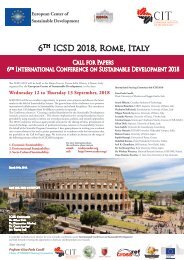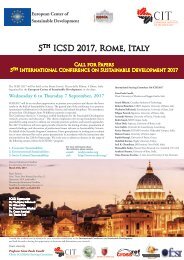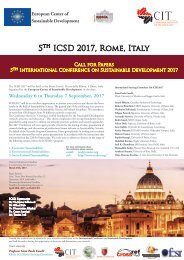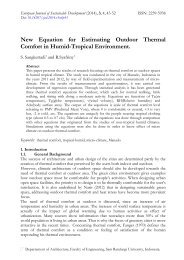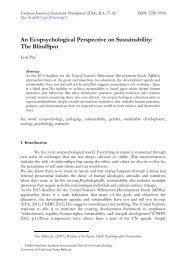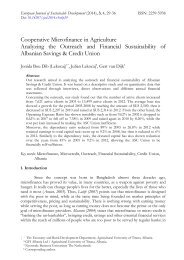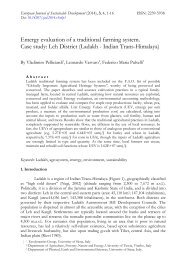Study of particulate matters pollution related with meteorological factors for a city from South-Central of Romania
Reducing the effects of climate change and air pollution is at present a global priority. Development and implementation of effective policies in order to achieve these reductions is a challenge that requires a good understanding of the underlying phenomena of climate change and air pollution. This paper aims to highlight the seasonal variation of PM10 concentration in Pitesti city depending on major meteorological factors (temperature, intensity of solar radiation, and relative humidity). The applied methodology consists in statistical processing, using specialized software, of a database containing historical records of concentration values of this pollutant and of meteorological parameters recorded concurrently. The results of processing a series of approximately 30000 values recorded from 2008 to 2011 indicate the fact that in every season (winter,spring, summer, and autumn) the concentration of PM10 varies according to a sixth degree polynomial function, whose variable is one of the considered meteorological factors. The mathematical relationship that best approximates the variation of average PM10 concentration in relation with the three meteorological factors is by the form of a multiple linear regression equation. Keywords: air pollution and human health, particulate matters related with meteorological factors, statistical analysis
Reducing the effects of climate change and air pollution is at present a global priority. Development and implementation of effective policies in order to achieve these reductions is a challenge that requires a good understanding of the underlying phenomena of climate change and air pollution. This paper aims to highlight the seasonal variation of PM10 concentration in Pitesti city depending on major meteorological factors (temperature, intensity of solar radiation, and relative humidity). The applied methodology consists in statistical processing, using specialized software, of a database containing historical records of concentration values of this pollutant and of meteorological parameters recorded concurrently. The results of processing a series of approximately 30000 values recorded from 2008 to 2011 indicate the fact that in every season (winter,spring, summer, and autumn) the concentration of PM10 varies according to a sixth degree polynomial function, whose variable is one of the considered meteorological factors. The mathematical relationship that best approximates the variation of average PM10 concentration in relation with the three meteorological factors is by the form of a multiple linear regression equation.
Keywords: air pollution and human health, particulate matters related with meteorological factors, statistical analysis
Create successful ePaper yourself
Turn your PDF publications into a flip-book with our unique Google optimized e-Paper software.
G. Mitran, S. Ilie 19<br />
following: (1) traffic type stations, (2) industrial type stations, (3) urban background type<br />
stations, (4) suburban background type stations, (5) regional background type stations<br />
and (6) EMEP (European Monitoring and Evaluation Programme) type stations, <strong>for</strong><br />
monitoring and evaluation <strong>of</strong> air <strong>pollution</strong> in long distance trans-boundary context<br />
(Ministry <strong>of</strong> Environment and Forests, 2012). In the <strong>city</strong> <strong>of</strong> Pitesti are operating two air<br />
quality monitoring stations: station AG1 (<strong>of</strong> traffic type, whose representativeness radius<br />
is between 10 m and 100 m; the monitored pollutants are: NO, NO 2 , NO x , SO 2 , CO,<br />
PM 10 , BTEX, Pb, Cd, Ni, As) and station AG2 (<strong>of</strong> urban background type, whose<br />
representativeness radius is between 1 km and 5 km; the monitored pollutants are: NO,<br />
NO 2 , NO x , SO 2 , CO, O 3 , PM 10 , BTEX). Station AG2 is centrally located in the <strong>city</strong>,<br />
<strong>with</strong>in the pedestrian area and, in addition to station AG1, it monitors also the<br />
<strong>meteorological</strong> parameters (direction and speed <strong>of</strong> wind, pressure, temperature, intensity<br />
<strong>of</strong> solar radiation, relative humidity, the amount <strong>of</strong> precipitations).<br />
3.2. Analysis method<br />
The variation <strong>of</strong> PM 10 amount associated to urban background in Pitesti municipality,<br />
generated by stationary producing pollutants sources, as well as by mobile sources, in<br />
relation to the <strong>meteorological</strong> parameters - temperature, intensity <strong>of</strong> solar radiation, and<br />
relative humidity - was studied using logical scheme presented in Figure 1.<br />
Figure 1. Logical scheme <strong>for</strong> studying the dependence <strong>of</strong> PM 10 on <strong>meteorological</strong> parameters.<br />
© 2014 The Authors. Journal Compilation © 2014 European Center <strong>of</strong> Sustainable Development.




